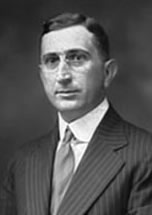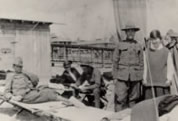The University of Virginia Hospital in World War I & World War II
Base Hospital 41 & the 8th Evacuation Hospital
The purpose of the United States Army Medical Department is to keep soldiers well and able to fight, or, if they are wounded or injured, to return them to duty as quickly as possible. The outbreak of World War II had almost immediate effects upon the Army and the Medical Department. In August 1939, the authorized enlisted strength of the Regular Army was 210,000. By June 1940, as the Nazis moved toward the English Channel, the number was raised to 375,000. After the fall of France, Congress approved a peacetime mobilization which resulted in the Army expanding to over 1,680,000 officers and enlisted men. Consequently, the Medical Department had to enlarge its operations both in the United States and in overseas possessions. Until the United States entered the war, field hospitalization and evacuation was unnecessary, but clearly medical units had to be prepared to serve in the event the United States entered the war. As early as March 1939 Surgeon General Charles R. Reynolds proposed the revival of “affiliated units.” These reserve units were sponsored by civilian hospitals and medical schools and played an important role in the Army’s hospitals in France during World War I. The Surgeon General wrote:
I am convinced that the Medical Department can have reserve hospital units ready to function as required … only by civil institutions sponsoring these units, especially those needed within the early periods of mobilization … [Smith, p. 5].

Dr. William H. Goodwin. Courtesy of C. Bruce Morton’s History of the Department of Surgery.
The University of Virginia sponsored hospital units in both world wars. After the United States entered World War I, Dr. William H. Goodwin received permission from the University to organize a hospital unit to send overseas and was appointed its director. Dr. Goodwin contacted the Red Cross in Washington D.C. and learned he would need to recruit all the supporting staff of the hospital as well as its doctors and nurses. It was also his responsibility to acquire funds to purchase the supplies for the hospital as the War Department had determined that only fully equipped and supplied hospitals would be accepted for active service.

Unit at Camp Sevier, South Carolina
The unit trained at Camp Sevier, South Carolina, under commanding officer Major (later Lieutenant Colonel) Julian M. Cabell, an 1886 graduate of the University of Virginia. Designated Base Hospital 41, the unit arrived at L’Ecole de la Legion d’Honneur outside Paris on July 26, 1918. When the Armistice was signed on November 11, 1918, nearly 3,000 patients were in the hospital. Two and a half months later, all the patients had been evacuated, and the hospital ceased to function.

Dr. Harvey E. Jordan
For several months after the United States entered World War II, it appeared the University of Virginia would not contribute a medical unit due to concern by Dr. Harvey E. Jordan, Dean of the School of Medicine, and others in the administration that the University could not properly staff both the University Hospital and a medical unit for the war effort. However, Dr. Staige Davis Blackford, Associate Professor of Medicine, believed that the University could do both as long as the hospital unit was formed with a nucleus from the faculty and supplemented by members of the resident staff and other physicians with ties to the University of Virginia. Dr. Blackford successfully persuaded the administration that the formation of a unit was feasible.